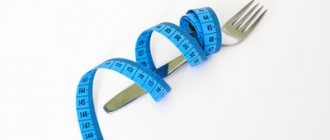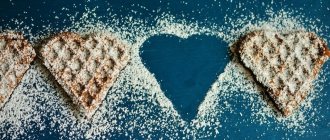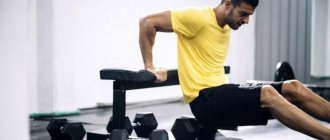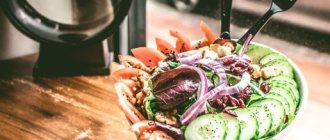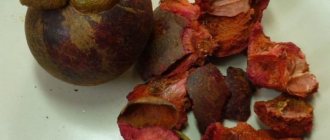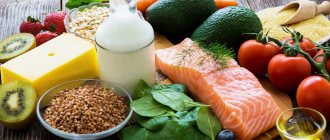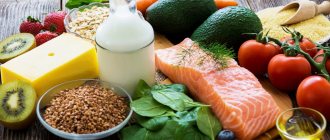The basic rule of a healthy approach to food and eating habits is maintaining a balance of nutrients and energy consumption (calories). Therefore, if you regularly engage in fitness, the composition and volume of your daily diet must be adjusted. This applies to all types of physical activity - it doesn't matter whether you prefer to calmly concentrate on your body while doing yoga or you like to do high-intensity interval training. Energy consumption changes, the menu needs to be selected in such a way as to get the maximum benefit from training.
It is not recommended to follow a strict restrictive diet when doing fitness. Only in extreme cases, for a short time, to lose one or two kilograms, carefully weighing the health risks. Feeling exhausted and weak, dieters cannot recover from physical activity and often quickly give up fitness. The other extreme is a menu that is too high in calories. You shouldn’t think that fitness “allows” you to eat uncontrollably.
The right approach is a varied, tasty diet for you personally with a balanced ratio of macro- and micronutrients and sufficient, but not excessive, calorie content. Such a diet will give you strength for training, your body will become not only fit, but also healthy, and your mood will always be high.
Maintaining protein-carbohydrate and drinking balance
It is generally accepted that nutrition during physically demanding activities should be predominantly protein. This is not entirely true: it is very important to supplement it with complex carbohydrates, which replenish the energy lost during training. Without them, you will constantly feel tired and weak, which will affect your athletic performance. The diet for athletes should also include fats - with the right dosage, they help maintain health and even promote weight loss.
The most important rule for proper nutrition for fitness is drinking balance. Enough fluid will help:
- avoid dehydration after exercise - it manifests itself in headaches, irritability, weakness, and rapid fatigue;
- improve intestinal and gastrointestinal motility, speed up metabolism and removal of harmful substances from the body - especially if the correct drinking balance is supplemented with a diet rich in fiber;
- lose weight more intensely.
To calculate the optimal amount of fluid, use the universal formula: 30 ml of water for every kilogram of body weight. The resulting volume should be evenly distributed throughout your waking hours, drinking the first 200-300 ml of liquid on an empty stomach, and the last one or two hours before bedtime.
Squirrels
Their importance in nutrition for fitness is invaluable. High-protein foods help “build” muscles faster, forming a beautiful relief, stimulate metabolic processes, promoting weight loss. The amount of protein should be at least 40-45%.
Carbohydrates
The optimal proportion of complex carbohydrates in the diet (from 40-45%) will fill the body with energy and protect against seasonal diseases. The most important nutrients, when oxidized in the body, “help” proteins build muscles. To maintain a balance between fitness and nutrition, it is advisable to eat carbohydrate foods in the first half of the day. To lose weight, avoid simple carbohydrates.
Fats
Fitness enthusiasts should not completely eliminate fats from their diet. They are needed by the immune, reproductive system, brain and other organs. It is advisable to increase the amount of vegetable fats, but not to give up animals, but to reduce their consumption. Give preference to a diet rich in polyunsaturated acids. Fats should not be left for the evening - their amount on the dinner menu should be minimal.
Diet
To balance fitness and nutrition, calculate the amount of calories needed to maintain your current weight, taking into account the physical demands of specific activities. This figure can be used as a starting point when creating a weight loss program. A correct and healthy calorie deficit should not exceed 300-400 kcal - it can be achieved by reducing the caloric content of food or just by fitness.
When planning your diet, remember:
- you need to eat in small portions - to maintain balance five times a day (three main meals and two snacks between them), for weight loss six to seven;
- the interval between meals should not exceed three hours;
- Breakfast should be hearty and dinner should be light, so foods high in fat and carbohydrates should be moved to the morning and afternoon.
It is advisable to eat dishes baked in the oven, steamed, stewed or minimally fried in vegetable oil. The diet should consist of lean meat, eggs, poultry, fish and plant products, and complex carbohydrates. When following a diet, give up carbonated drinks, foods containing a lot of sugar, fast food and other “harmful foods” - you can indulge in them, but not often.
Basic recommendations
- You need to eat in small portions, at least 5 meals a day.
- Before 16:00, 60% of the daily ration should be eaten.
- The last meal should be made of protein to give the body amino acids for recovery during sleep.
- The diet should have enough fiber: bran, vegetables.
- It is preferable to cook and steam foods, avoid frying and smoking.
- Eating should be done 2 hours before the start of training.
- If the workout is in the morning, then before it you need to have something light for breakfast: banana, smoothie, cottage cheese with berries.
- If you workout at lunchtime, then you need to eat protein foods, fresh vegetables or complex carbohydrates after sports.
- In the evening after training, you should not go to bed hungry. For dinner there can be fish, cottage cheese, kefir, tofu.
Nutrition after, before and during exercise
What to eat before fitness classes
When choosing what to eat before fitness, give preference to protein dishes that are low in calories and eat them no later than one to two hours before exercise. If you were unable to have a full lunch or dinner, half an hour before training you can eat a handful of berries, fruit, something fermented milk or drink a protein shake. 200-250 ml of tea without milk, sugar, or still mineral water will be useful.
What to do during classes
Fitness and nutrition don't go well together - it's better to give preference to drinking. It is necessary to drink water during training, carefully monitoring your condition and paying attention to signs of dehydration: dry mouth, dizziness, severe fatigue. You need to drink in small sips, every 15-20 minutes. If the duration of the training exceeds an hour, it is worth adding juice or a protein shake to the water. You should not drink a lot of fluids during physical activity, so as not to put extra stress on your heart.
What to eat after class
The body must replenish the energy expended, so athletes are recommended to take protein-carbohydrate foods – the “carbohydrate window” – after 40-100 minutes. It will help restore muscles, satiate, speed up metabolism, and replenish glycogen reserves. If you are on a weight loss diet, do a “carbohydrate window” one and a half to two hours after training. Your diet should include:
- omelette, steamed, boiled meat or fish;
- complex carbohydrates – whole grain pasta or bread, baked potatoes, brown rice;
- sour natural juice - cranberry, grape, orange (diluted with water).
It is advisable to have a minimum amount of fat in your diet after exercise. It is better not to use them at all for the first two hours after training. After 4 p.m., reduce your calorie intake, even if you have a high-intensity workout planned for the evening. Be sure to drink enough water afterward to replenish the loss of intracellular fluid.
Examples of menus for fitness classes
To maintain the right balance between fitness and nutrition, you need to choose healthy foods that fill you up, replenish the loss of vitamins and nutrients, but do not make you feel heavy. To make it easier to navigate, we will give examples of universal dishes for those involved in fitness.
For breakfast while on a diet, omelettes with stewed vegetables, whole grain toast, nuts or nut butter are recommended. You can stick to oatmeal or similar porridge, boiled brown rice with chicken breast, or lean steak. For lunch you should choose soups in light broths with cereals, meat, fish with a vegetable side dish, dairy products, including cheese. Complex carbohydrate cereals, low-fat cottage cheese, poultry, seafood, decoctions of berries and rose hips are suitable for dinner.
The diet should consist of:
- lean meat - chicken, veal, turkey;
- fish rich in Omega-3 acids and seafood, which are high in protein and microelements;
- eggs – to lose weight, eat only protein;
- green vegetables - spinach, cucumbers, cabbage, celery (but be careful with avocados, they are healthy, but high in calories);
- seasonal fruits and berries with a low glycemic index - apples, strawberries, etc.;
- vegetable oils, nuts and seeds (in small quantities);
- low-fat fermented milk products, milk 2-5% fat;
- bran bread, whole grain pasta, unprocessed cereals;
- greenery.
To get the maximum benefit from fitness, you need to be careful about food, its composition and quality. But what to do if you have no time or desire to cook? The BeFit service will help you balance fitness and nutrition without unnecessary hassle. Specially developed ready-to-eat meal delivery programs are convenient for everyone who watches their form. Neatly packaged containers, convenient to take with you, KBZHU in products is precisely selected for a specific purpose. The programs will help you gain muscle mass, lose weight, or maintain an optimal regime during active sports. Choose your delicious, varied menu and always be in shape with BeFit.
Healthy food delivery Moscow | Delivery of ready-made food for a week reviews | Diet business lunch | Detox juices with delivery | Order fish dishes | Complex for weight loss | Delivery of ready-made sports nutrition | Order vegetarian food to your home in Moscow
Gradually improve your diet.
Were you surprised by what you found in your weekly diet magazine? Otherwise, it looks like your diet is barely being followed. It doesn't matter what your starting position is, what matters is what steps you take to improve your diet.
Starting a diet based on foods you don't know, copying your diet from social media fitness celebrities, or going gluten-free is not the solution. We all live different lives in our own way, we have different habits and needs. But what will work? Small steps that will become big steps over time.
Gradually try to eat less so-called highly processed foods , which are characterized by being highly processed and containing excessive amounts of salt, sugar, unhealthy fats and refined sugar. On the contrary, they are low in fiber, protein, vitamins and minerals. These foods are also less filling and have high caloric density (energy density) in relatively small volumes, which is why they are associated with weight gain, obesity, and other civilization-related diseases. [3]
Processed foods typically include most fast food items, potato chips, candy bars and other salty snacks, and an endless array of sweets and baked goods . Increase your intake of fruits, vegetables, fiber and protein. Ideally, your food can be described as full of color with different types of fruits, vegetables, legumes, grains and other food ingredients. You will receive a diverse range of antioxidants, vitamins, minerals and other important micronutrients.
What should your meal ideally look like at the end of each day?
What are proteins, fats and carbohydrates?
- Protein sources: meat, fish, seafood, milk, dairy products and cheese, eggs, legumes (peas, beans, all types of lentils, chickpeas, edamame), pseudograins (buckwheat, amaranth, quinoa), tofu, tempeh, nuts and seeds, vegetable meat substitutes, fine yeast, whey protein, plant protein, protein bars.
- Sources of fats: nuts and seeds, oils, olives, avocados and butter as a natural component of animal proteins.
- Sources of carbohydrates: whole grains and cereals (oatmeal, flour, rice, pasta, bread and baked goods), pseudograins, potatoes and sweet potatoes, legumes, fruits and vegetables.
It is recommended to eat at least 400 grams of vegetables and 200 grams of fruit per day , which is approximately 4-5 and 2-3 average-sized servings, respectively. If you are bothered by sugar cravings and want to get rid of them, read our article 15 steps on how to get rid of sweet cravings.
